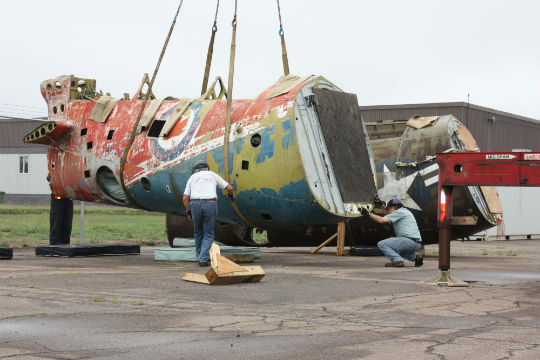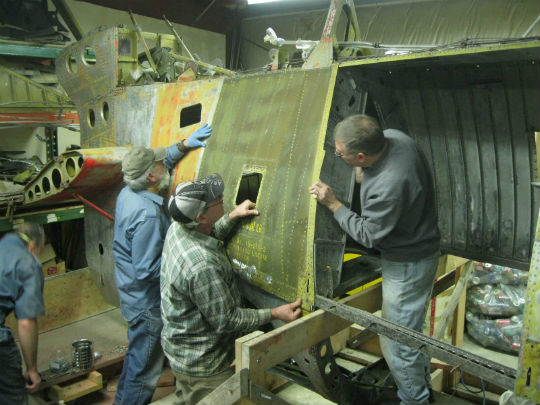Estimated reading time 6 minutes, 10 seconds.
Workers lower the tail section of the Piasecki/Vertol H-44 helicopter. Malcolm Uhlman Photo
When Paul Blinn looks at the Piasecki/Vertol H-44 helicopter he’s helping restore for Greenwood Military Aviation Museum, he sees traces of the Boeing Vertol CH-113 Labrador.
Both are tandem-rotor aircraft used for search-and-rescue missions in the Canadian Armed Forces and both are shaped a bit like tropical fruit.
The H-44’s nickname was the ‘Flying Banana,’ and the Labrador is vaguely similar, with nose and tail sections that rise upward from a long, tube-shaped body.
“The parts and pieces are just slightly different but you can see where they’re all related, family-wise,” said Blinn, 56, a retired Royal Canadian Air Force (RCAF) warrant officer and flight engineer who flew Labradors.
“[The H-44 is] a great piece of history. That’s the thing we’re working on.”
The restoration team. Back row, from left: Larry Abbott, Paul Blinn (team leader), Peter Miller and Greg MacWah. Front row: Malcolm Uhlman and Chris Young.
Blinn is leading a six-person group of retired volunteers in restoring the H-44 at the museum, which is located at Canadian Forces Base Greenwood in Nova Scotia’s Annapolis Valley. The H-44 flew with 103 Rescue Unit out of RCAF Station Greenwood around 1961.
Work began in June 2014 on the tail section of the helicopter, which Maj Robert Johnson, the museum’s general manager, discovered on a trip to the Reynolds
Heritage Preservation Foundation in Wetaskiwin, Alta.
A snowplow is said to have struck the nose section of the helicopter, rendering it impossible to rebuild.
The crew acquired the nose of a United States Army H-21—a version of the same helicopter—and plans to modify it to H-44 specifications, bolt the two halves together and paint them in 103 Rescue Unit’s red, white and blue livery.
Cockpit material and other parts will come from a third aircraft the museum had trucked up from North Carolina, said Malcolm Uhlman, another crewmember.
“We haven’t got the engine, but we’re still looking,” he said.
Larry Abbott, left, Greg McWash and Paul Blinn work on the tail section of a 1960s-era Piasecki/Vertol H-44 search-and-rescue helicopter. Malcolm Uhlman Photo
The museum has embarked on many restoration projects, including an Argus CP-107, a Neptune P2V, a Silver Star CT-133, an Avro Anson, a C-47 Dakota, an Avro Lancaster and a Labrador helicopter. The museum is also in the process of restoring a Bristol Bolingbroke.
“When you get those things finished and in the air park and you get the old veterans that come along—some of them aren’t that old, but they flew the deck or in a Dakota, and they say, ‘What a lovely aircraft that was.’
“Or, in the Argus … ‘I worked on those engines.’ They’re wowed to see it and be able to walk up and touch it. So to me, that’s what it’s all about,” said Uhlman.
The crew has logged more than 2,500 man-hours on the H-44 project so far, with plans to finish the tail section by June. Work on the cabin and cockpit section is expected to take another two years.
The crew has logged more than 2,500 man-hours on the H-44 project so far, with plans to finish the tail section by June. Malcolm Uhlman Photo
A major challenge has been acquiring missing parts, including seats and a rescue hoist. Along with an R1820-103 engine, Blinn and the crew are still looking for auxiliary fuel tanks and various other pieces.
“We don’t let it bother us that much,” said Blinn. “If we’ve got an engine, great. If we don’t, we don’t. That’s just part of it …. We can do lots of work without trying to find all that stuff for the time being. The aircraft itself will basically be there.”
The restoration work has been a labour of love for Blinn, who feels connected to the H-44 through his experience with Labrador rescue helicopters.
“It’s something we have to grab hold of, because it’s part of our history,” he said.
“In order to go forward you’ve got to know where you came from, and aircraft are exactly the same way.”








do you have history and photos of markings (lightning strike) on earler piasecks (1952)